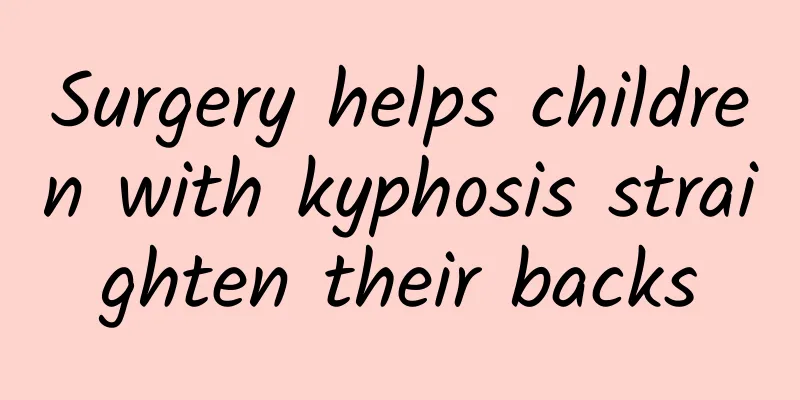Surgery helps children with kyphosis straighten their backs

|
Author: Shen Jianxiong, Chief Physician, Peking Union Medical College Hospital Reviewer: Zhang Zhihai, Chief Physician, Guang'anmen Hospital, China Academy of Chinese Medical Sciences Congenital kyphosis is an abnormal curvature of the spine that appears in infancy or adolescence. It not only affects the patient's body shape, but may also have a serious impact on growth and development, cardiopulmonary function and daily life. With the continuous advancement of medical technology, the understanding of this disease and the treatment methods are also becoming more and more perfect. In terms of treatment strategies, there are various ways to deal with congenital kyphosis, which mainly depends on the severity of the disease, the patient's age and growth and development. For most patients, conservative treatment is usually not the first choice because it is difficult to fundamentally correct structural spinal abnormalities. Only when the deformity is extremely mild and there is no obvious trend of progression, conservative treatment may be tried under the guidance of a doctor, such as physical therapy, posture training, etc., to delay the progression of the disease. However, for most moderate to severe and progressive congenital kyphosis, surgical treatment is almost inevitable. The purpose of surgery is to restore the normal physiological curvature and function of the spine by removing the abnormal structure that causes the deformity (such as hemivertebra), performing spinal osteotomy and correction. This process requires not only delicate surgical skills, but also consideration of the patient's growth and development potential and the long-term effects after surgery. Figure 1 Original copyright image, no permission to reprint When it comes to surgical methods and timing, there are many methods for treating congenital kyphosis, but the basic principle is to remove the cause, correct the deformity and stabilize the spine. For early-stage hemivertebrae, surgical resection of the hemivertebra can effectively prevent the deformity from developing further. For younger patients with milder deformities, doctors may use growth control techniques, such as anterior growth extension and posterior bone graft fusion, to slow down the progression of the deformity. Figure 2 Original copyright image, no permission to reprint The timing of surgery is crucial. Generally speaking, there is no fixed age limit for surgery. The key lies in the discovery and progression of the disease. Once congenital kyphosis is diagnosed and the deformity is observed to be worsening, or it is judged that it may worsen in the future based on literature experience, surgical treatment should be considered as early as possible. This can not only minimize the damage to spinal function caused by the deformity, but also reduce the risk of surgery and the incidence of complications. The management of surgical risks and complications should not be ignored. Spinal cord injury is one of the main risks of congenital kyphosis surgery, which may lead to serious consequences such as paralysis or incomplete paralysis of the lower limbs. With the advancement of medical technology, the incidence of such complications is gradually decreasing, but it is still higher than other types of spinal surgery. In order to reduce these risks, doctors will take various measures to protect the spinal cord during surgery and pay close attention to the patient's neurological function status after surgery. Once neurological symptoms occur, the first task is to determine whether there is compression of the spinal cord by bones or soft tissues and to take appropriate measures to relieve the compression. If the spinal cord injury is not irreversible, it can be remedied through reoperation or other methods. However, since the spinal cord is already in an extremely fragile state in such diseases, any operation must be extremely cautious to prevent further damage. Postoperative rehabilitation is just as important as long-term management. In the early postoperative period, patients need to wear a brace to support bone healing, which may last for several months. In the first few months, patients can gradually resume daily activities under the guidance of their doctors. Generally, it takes about six months to a year for patients to achieve stability of the bone graft, and complete bone healing may take ten months to more than a year. Postoperative follow-up is essential to ensure good wound healing, stable internal fixation, and bone healing. Generally speaking, the first three months after surgery focus on wound healing, and then regular follow-up is required until the bones are fully mature. Children are still in the growth and development period and need to be followed up more frequently, while the follow-up interval for adult patients can be appropriately extended. Patients and their families often worry about whether they can resume normal activities after surgery. In fact, under the guidance of doctors, patients can gradually resume normal daily activities, including physical exercise, during the recovery process. Moderate exercise is helpful for recovery, while overprotection may cause psychological burden and affect the recovery effect. |
>>: Congenital Scoliosis: When to be conservative? When to be surgical?
Recommend
How to use female contraceptive gel
For couples who do not want children yet or want ...
What are the dangers of quarreling and getting angry during menstruation?
I believe that many girls will find that they are...
Is it good to drink milk after eating barbecue? What is the best way to eat barbecue?
In life, it is also called clams. It is one of th...
Why do I need to be on an empty stomach for blood draw? Does drinking water count as being on an empty stomach? I finally figured it out today.
For hospitalization, blood draws are usually done...
When is the best time for postpartum fumigation?
Many mothers are very weak after giving birth. In...
Several disadvantages of women crossing their legs
I believe that the majority of female movie frien...
What are the dangers of milky white fluid discharge from the vagina?
Vaginal discharge of milky white fluid is a relat...
Elderly people love to drink tea. Which is healthier, strong tea or weak tea?
Mr. Zhang, who is in his 60s, told Huazi that he ...
Back pain after painless injection
Pregnancy and childbirth is a critical moment tha...
What is the reason for frequent contractions at 38 weeks?
Pregnant women need to pay attention to many thin...
Can I use air conditioning during confinement?
Many women give birth in summer so the weather is...
The reaction before menstruation
Women often have a variety of reactions before th...
What should I do if the abortion is not clean after the medication?
Women have always played a very important role in...
Spring is a good time to nourish the liver. What should we pay attention to in terms of sleep, exercise and diet?
Author: Sun Fengxia, Chief Physician, Beijing Hos...
Can I have an abortion in the early stages of pregnancy?
I believe everyone knows what abortion is. Aborti...









